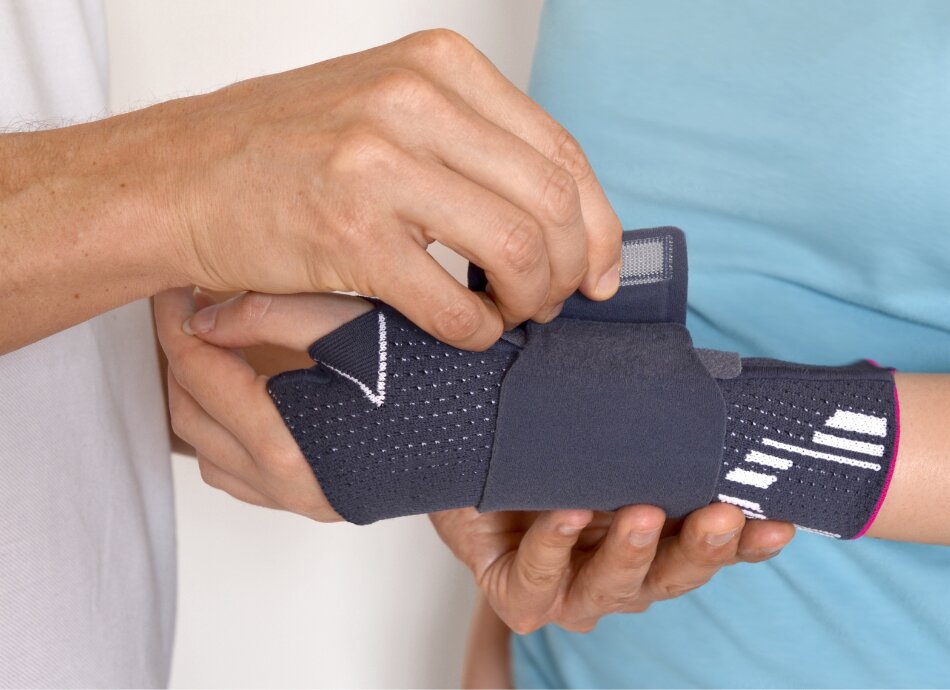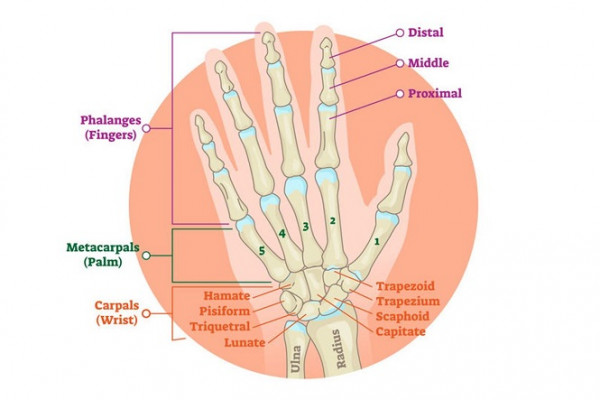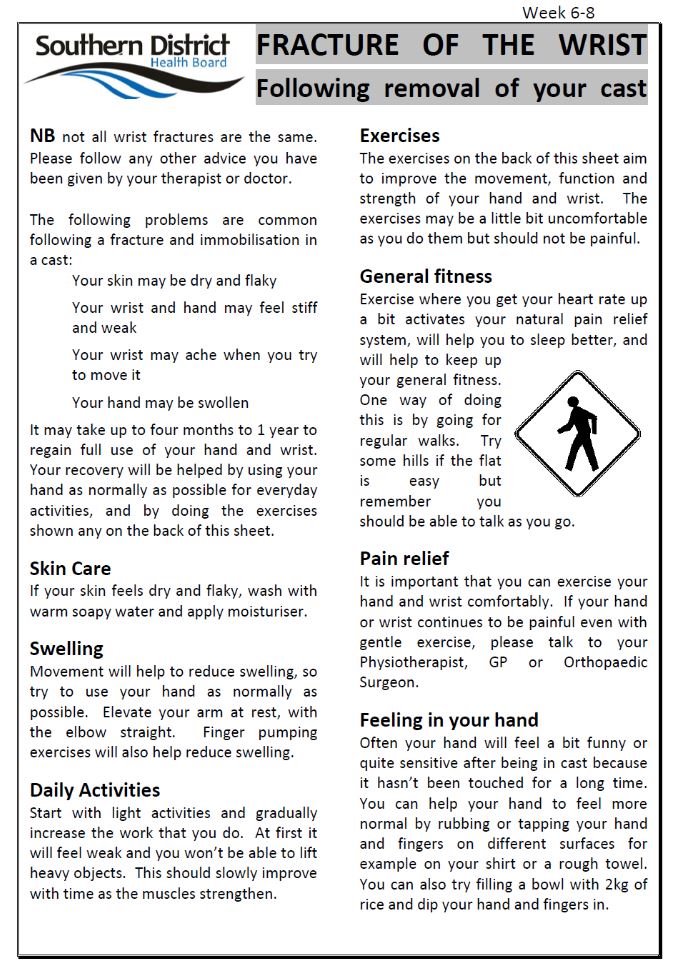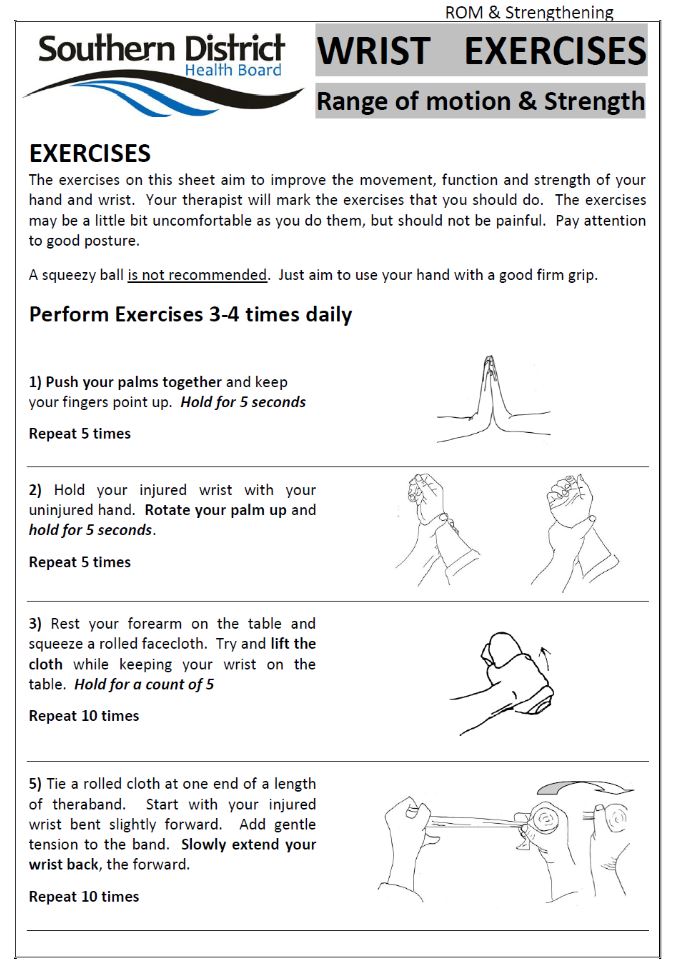Broken wrist
Key points about broken wrist
- A broken wrist is the fracture of any bone in your wrist and is usually due to falling on to an outstretched hand.
- Common symptoms of a broken wrist include severe pain, swelling or bruising, tingling or numbness of your hands or fingers, and difficulty moving your hands.
- A broken wrist is usually diagnosed with an X-ray but it's sometimes difficult to see.
- Treatment aims to put the broken bones back together so the bone can heal properly and you get back normal movement of your wrist.
- For minor breaks, you will need to wear a cast or splint. Major breaks may require surgery.

Your wrist joint is made up of several bones. These include the 8 carpal bones, the radius and the ulna. Any of these bones can break. However, the more common wrist fractures include:
- distal radius and ulna fracture
- scaphoid (one of the carpal bones) fracture.
The cause of a broken wrist is usually due to a fall on to an outstretched hand. Other causes include:
- serious accidents such as motor vehicle accidents
- a break that occurs in a weak bone, such as if you have osteoporosis.

Image credit: 123rf
Common symptoms of a broken wrist include:
- severe pain in your wrist
- swollen wrist
- a bruise around your wrist
- tingling or numbness of your hands or fingers
- difficulty moving your hands and fingers
- your wrist appears odd in shape.
If you think you or someone you care for has a broken wrist, you should:
- go to the nearest emergency department or call 111 if it is broken badly
- contact your GP if it is a minor break
- stop using or avoid moving the injured arm as much as possible
- apply pressure to stop bleeding using a clean pad or dressing if there is any bleeding
- ice the injured area using an ice pack wrapped in a clean towel
- avoid eating and drinking in case you need surgery to fix the broken bone.
How is a broken wrist diagnosed?
If you think you may have a broken wrist, you should see a doctor straight away.
Your doctor will assess your general condition, as well as the seriousness of your injury. They will ask about how the injury happened, any symptoms and your medical background.
The most common way to diagnose a fracture is by an x-ray. These show the type of break and its location within the bone. Sometimes, a wrist fracture is hard to see on an x-ray. In that case, you may get a repeat x-ray after a week or more, or have a CT scan or MRI scan, depending on what the doctor thinks is most useful.
How is a broken wrist treated?
Treatment of a broken wrist aims to put the broken bones back together so that the bone can heal properly and you get normal movement of your wrist back.
The treatment you receive depends on how bad the break is. Other factors that affect your treatment include:
- the type of fracture
- your age
- whether the bones have moved or been displaced
- whether the bones break through your skin
- the number of bone fragments from the fracture
- your job or usual activities.
If you have a minor fracture, you will usually be treated with a cast or splint to hold your bones together and support your wrist while it heals.
If you have a more serious fracture, your doctor will try to realign the bones together, either manually using hands or through surgery to insert pins, plates or screws to hold your bones in place.
In both cases you will be given painkillers and be advised on the care following treatment. This may involve physiotherapy or hand therapy.
You will need to wear a cast until the bones heal. This will usually take 4–6 weeks, or longer if the fracture is more serious.
Sometimes after the cast comes off it may be useful to wear a splint some of the time, so that you feel comfortable and confident to use your hand again, but a splint is not always necessary.
If you have had surgery and the bones are well fixed with a plate and/or screw(s), you might only have the cast on for 10–14 days. After that you may wear a splint for some or all the time for 3–4 weeks, but you can start moving your wrist, usually under the guidance of your surgeon and/or physiotherapist or hand therapist.
Do not expect your hand and wrist to be normal as soon as the cast comes off. Eventually, your hand and wrist will work well again, but it will take time.
There are several self-care measures that you can do to help the recovery of your broken wrist. These include:
- taking regular pain killers if you have any pain
- keeping your arm elevated on a pillow or with a sling in the first week, but after that start to let your arm be part of your everyday life again
- doing gentle exercises as advised by your health providers
- avoiding heavy lifting or activities that require your wrist to work hard
- positioning your arm with your thumb up rather than letting your arm rest with the palm down all the time as this will help lessen stiffness later
- keeping your cast dry
- stopping smoking.
Read more about care of your broken wrist while in a cast [PDF, 509 KB].
After your cast is removed, you may find your wrist is stiff, your skin dry or your hand swollen. It may take 4 months to 1 year to regain full use of your hand and wrist. Your recovery will be helped by using your hand as normally as possible for everyday activities and by doing any exercises your doctor recommends.
Read more about caring for your wrist following removal of your cast [PDF, 331 KB].
Apps reviewed by Healthify
You may find it useful to look at some First aid and emergency apps.
The following links provide further information about broken wrist. Be aware that websites from other countries may have information that differs from New Zealand recommendations.
Care of your wrist and hand following a fracture(external link)(external link) HealthInfo Canterbury, NZ
Exercises of your arm and hand while in a cast(external link)(external link) HealthInfo Canterbury, NZ
Distal radius fractures (broken wrist)(external link)(external link) OrthoInfo, US
Broken arm or wrist(external link)(external link) NHS, UK
Apps
Resources
Care of your broken wrist (distal radius fracture) while in cast [PDF, 509 KB] Southern DHB, NZ, 2015
Fracture of the wrist – following removal of your cast [PDF, 331 KB] Southern DHB, NZ
Wrist exercises – range of motion and strength [PDF, 488 KB] Southern DHB, NZ
References
- Wrist fractures in adults(external link)(external link) Auckland Regional HealthPathways, NZ, 2020
- Wrist fractures(external link)(external link) Patient Info, UK, 2016
|
The content on this page will be of most use to clinicians, such as nurses, doctors, pharmacists, specialists and other healthcare providers. |
The following information about wrist fractures in adults(external link)(external link) is taken from Auckland Regional HealthPathways, accessed April 2020:
About wrist fractures in adults
Wrist fractures include:
- Distal radius and ulna fractures
- Scaphoid
- Other carpal fractures (uncommon)
Assessment
- Take history of the injury. If mild trauma with a fracture, consider osteoporosis.
- Check neurovascular status. Check for tenderness in anatomical snuffbox looking for a scaphoid fracture.
- Arrange ACC-funded radiology. If there is obvious deformity or other signs of fracture, provide pain relief and immobilisation before X-ray.
- Determine the type of fracture.
Management
General management
- Most will require manipulation and reduction under analgesia. If unstable, surgery will be required. Provide analgesia for transport.
- Look for an associated avulsion of the ulnar styloid process.
- If after hours, consider analgesia and a back slab with referral the following day.
- Consider whether this is a minimal trauma fracture and contact Fracture Liaison Service for assistance arranging appropriate investigation and treatment.
- Ensure early mobilisation of fingers, elbow, and shoulder from time of injury.
- Once POP is removed, request physiotherapy assessment for active exercise programme.
- Consider allied health support if patient is:
• experiencing barriers to recovery, or if there is a strength, ROM, proprioceptive, and functional deficit, or if pain is a key feature. Consider physiotherapy assessment.
• experiencing difficulty with everyday activities. Consider occupational therapy.
• returning to work, or sustaining work tasks. Consider work assessment and rehabilitation.
Apps
Brochures

Southern DHB, NZ, 2015

Southern DHB, NZ

Southern DHB, NZ
Credits: Healthify editorial team. Healthify is brought to you by Health Navigator Charitable Trust.
Reviewed by: Dr Miranda Buhler, physiotherapist and hand therapist
Last reviewed:
Page last updated:





